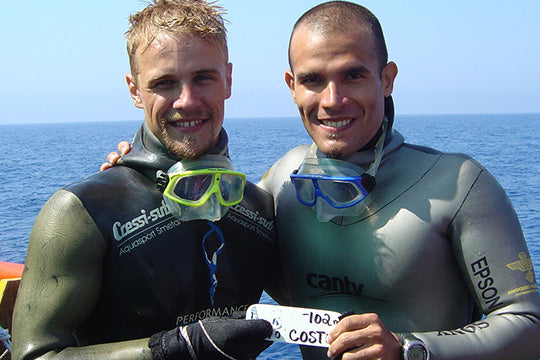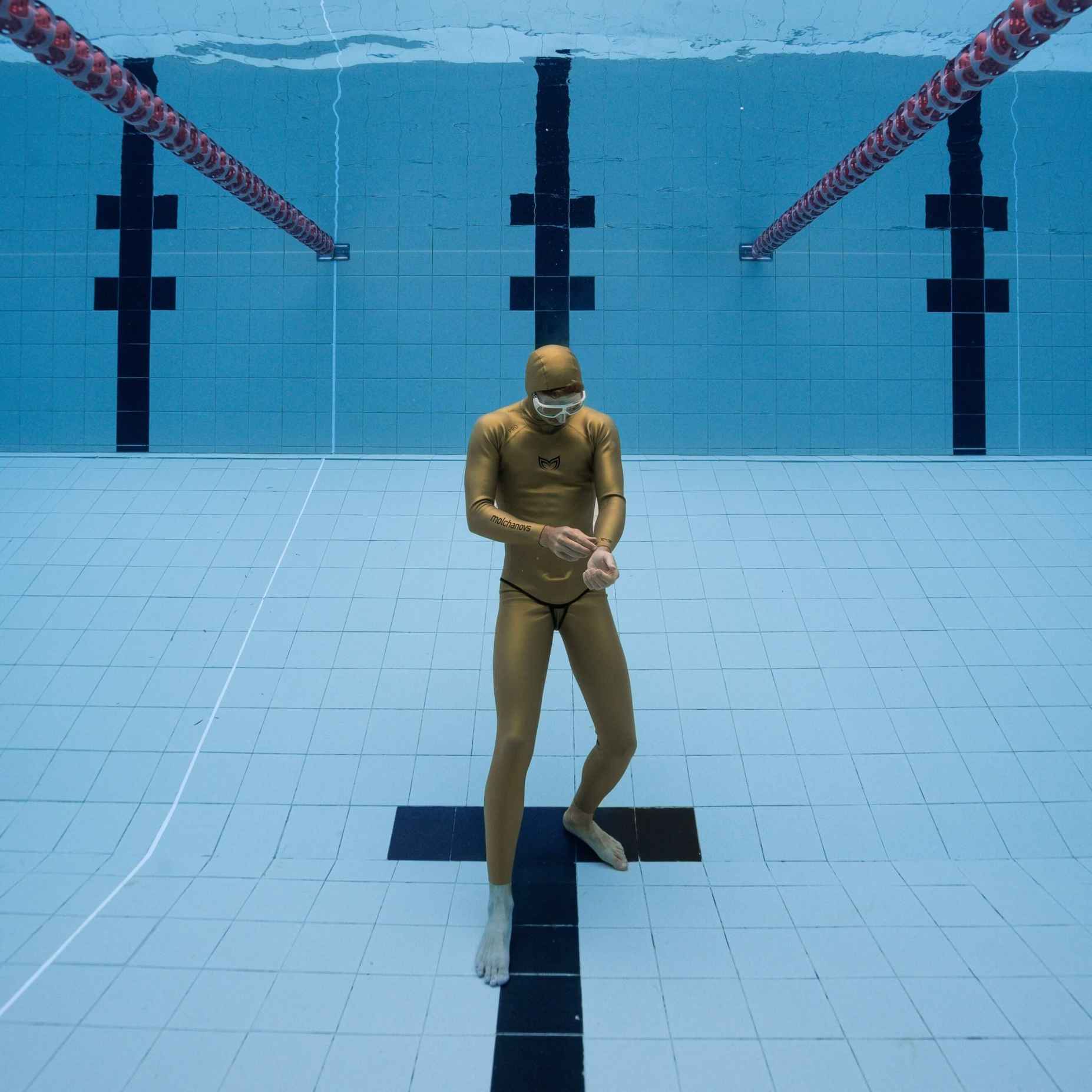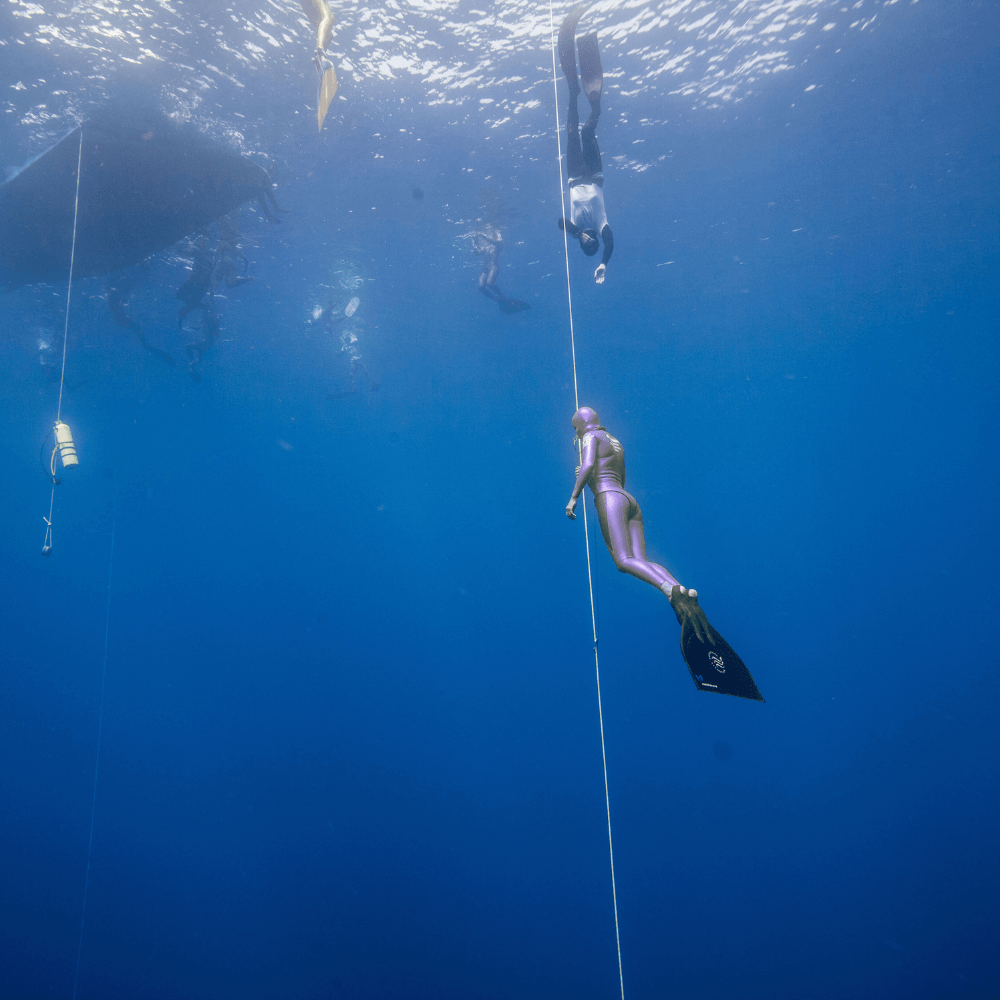Cyprus Freediving Stories: The first official CWT dive that broke the 100m barrier

Asya Kleshchevnikova
Sports Columnist and Head of Customer Service & International Sales
asya@molchanovs.com
molchanovs.com
Kristina Zvaritch
Editor
It is the second Monday before the 27th AIDA World Championship, which means that it is time for our next Cyprus freediving story.
(Reminder: every week before the 27th AIDA World Championship, we will post a story that took place in freediving history. Our first story was about the first international competition of Natalia Molchanova, which you can find here).
This story is about the events that took place in Cyprus in the 2004 BIOS Freeology Open Classic competition, where 83 athletes performed in two pool disciplines and one depth discipline: DYN, STA, and CWT.
In the CWT portion of the competition, the depth range varied from 16m/52ft to 103m/338ft, meaning that absolute beginners competed alongside old-school freediving warriors. The most exciting rivalry occurred between the legendary athletes Herbert Nitsch of Austria, Martin Štěpánek of the Czech Republic, and Carlos Coste of Venezuela.
 17 July 2004, Limassol, Cyprus. The photo from Carlos Coste archive.
17 July 2004, Limassol, Cyprus. The photo from Carlos Coste archive.
Since the very first CWT world record set by Umberto Pelizzari of Italy in 1995 to 75m/246ft, FIM performances surpassed CWT performances. For freediving fans who have only been watching freediving competitions within the last 10 years, this may seem very strange, since in this day and age, CWT is known as the deepest discipline among the competitive depth disciplines. This fact has several explanations. At the very beginning of official freediving competition inception, most athletes competed in CWT with bifins. It was only in the 2000s that almost all athletes (including top freedivers) switched to using a monofin and began working on their dolphin kick technique. This is the same equipment and technique athletes use today, including Alexey Molchanov, who reached the deepest CWT depth to date of 131m/430ft.
Additionally, we received input from Carlos Coste on the performance differences between CWT and FIM. Carlos explained that at the time, FIM was easier and more accessible for training than CWT, as there is less of a demand on swimming technique. Furthermore, the diving time required to dive those depths was “manageable” for athletes. Later, as the depths reached became deeper and deeper every year, FIM dives became too long for athletes (dive times were extended along with the depths, while the speeds of the dives were very limited).
What makes these past competitions even more interesting is that athletes completed their deep dives wearing a mask, which makes deep equalization even more complex. In current times, almost all of the athletes who dive deeper than 100m/328ft do so with nose clips.
Let us return back to 2004, the year that became a real breakthrough for freedivers. For nine long years, performances in CWT remained shallower than 100m/328ft. However, in 2004, three of the world's best freedivers to date claimed that they had dived to depths up to 105m/344ft during their training sessions. On July 17, 2004, the deepest depths announced at the BIOS Freeology Open Classic competition were as follows:
- 103m/338ft - Martin Štěpánek (Czech Republic)
- 102m/335ft - Carlos Coste (Venezuela)
- 102m/335ft - Herbert Nitsch (Austria)
Before that day, all of these athletes previously held world records in CWT and were rivals for at least three years, constantly surpassing one another’s world records. This meant that, in theory, they all had equal chances of winning. This feeling of unpredictability in regards to freediving competition winners is something that we are definitely missing these days!
Martin Štěpánek dived first. Unfortunately, he became very cold before his dive, and according to other participants in the competition and onlookers, Martin was visibly shivering. Despite that fact, Martin proceeded with his dive, but returned two-and-a-half minutes later without a tag. The cold reduced Martin's diaphragm flexibility, which caused him to face an equalization issue at 90m/295ft of depth, leading him to make an early turn at 98m/322ft, just 5m/16ft shy of his target depth.
Carlos’ performance was next. Diving on a nearby line, he was halfway to the bottom when he met Martin on his return to the surface. For Carlos, it was important not to get distracted by this, and he managed to do so successfully. After arriving to the surface, it was clear that Carlos was very cold, yet he appeared with the bottom tag and a smile, leading him to receive a white card!
Herbert Nitsch was preparing for his dive at the same time Carlos was completing his surface protocol. This affected Herbert's preparation, which forced him to make a decision between not packing to his fullest extent or risk a late start. Herbert chose to pack less than planned rather than be disqualified for a late start, although it unfortunately resulted in an early turn at 88m/289ft after he ran out of air for equalization.
This is how Carlos Coste had his name written in the history of freediving as the first man who completed an official CWT dive beyond the 100m/328ft barrier. A great event to remember and to celebrate!
 Natalia Molchanova and Carlos Coste after successful dives on 17 July 2004, Limassol, Cyprus. The photo from Carlos Coste archive.
Natalia Molchanova and Carlos Coste after successful dives on 17 July 2004, Limassol, Cyprus. The photo from Carlos Coste archive.
We spoke to Carlos and he kindly shared his memories and experiences with us. It is an honor for us to have the opportunity to make this rare information public.
Molchanovs: When and why did you start using a monofin for your CWT dives?
Carlos Coste: I switched to a monofin in 2001 after I saw the world record dive of Herbert Nitsch at the AIDA World Championship in Ibiza (82m/269ft). I started to train with a basic monofin, and then I set my first CWT world record in 2002 (90m/295ft) with very basic technique! Yes, the monofin became a very powerful tool for me that helped me push my limits much further in a very short time.
M: On that historic day in 2004, there were three of you whose target depth was below 100m/328ft, and only you managed to reach it. What do you think happened with Martin and Herbert? They were strong competitors as well.
CC: It was an exciting competition even before it started. During the training days, I didn’t expect to dive to 105m/344ft in one of my sessions, and it was an awesome surprise for me. I tried to keep it a secret, but the rumors spread like wildfire. Then it became a gamble. I announced a safe performance of 102m/335ft, as I knew I would manage to stay calm and focused. The event was big, with a lot of cameras and many people, and I didn’t want to feel nervous, as I was not used to all that attention. But Martin and Herbert announced deeper performances.
When I saw the announced performance list the night before, I felt a little bit disappointed because I thought, my WR will last only a few minutes if they made their performances. But I stayed focused and told myself that I will do my best! This is why I came. Maybe all that media and public pressure and pushing big depths affected their dives. For the year 2004, those depths of 100-105m (328-344ft) were incredible.
 Carlos Coste grabbing his tag at -102m depth on 17 July 2004, Limassol, Cyprus. The photo from Carlos Coste archive.
Carlos Coste grabbing his tag at -102m depth on 17 July 2004, Limassol, Cyprus. The photo from Carlos Coste archive.
M: Did you already expect that Martin and Herbert's announcements were going to be deeper than 100m/328ft? Were you sure you would win? Or were you surprised when you managed it so smoothly?
CC: Yes, I did expect a battle for the 100m/328ft, but I was not sure how far they were going to dive. As you know, it is one thing to announce your depth, but the final performance might not be successful. I did not have the certainty of winning, but I knew I would give my best performance, as I trained and knew I was ready to dive to the depth I announced.
M: Do you remember your feelings after the dive? How does it feel to perform a historical dive?
CC: I felt elevated and super happy when I realized that I was the only one below 100m/328ft in this renowned contest. The feeling to achieve a depth that nobody could before was incredibly satisfying. I was very proud of myself to be able to manage all the tension and pressure during the dive.
 Martin Štěpánek and Carlos Coste on 17 July 2004, Limassol, Cyprus. The photo from Carlos Coste archive.
Martin Štěpánek and Carlos Coste on 17 July 2004, Limassol, Cyprus. The photo from Carlos Coste archive.
M: If I am not mistaken, you have not taken part in world championships for several years already. Do you have plans to return? It would be exciting to see you competing again.
CC: My last World Championship was in Kalamata in 2011 where I did my best CWT dive (116m/381ft, current Panamerican record). I competed in a few other events and did a Guinness record in DYN in open water, but my main focus has been on my school in the last few years. Yes, I would like to compete again, maybe in 2022.
We are looking forward to seeing competitions in 2022 and wish Carlos the best of luck!
We believe that it is our mission to remember these historical events that gave our sport new perspectives and depths. For those who would like to memorialize this important historical freediving location, we are preparing Cyprus special edition equipment, which will include monofins, bifins, and t-shirts with unique and subtle designs devoted to Cyprus.
Today, we are thrilled to present to you the design of our special edition gear. It reflects the depth map near Limassol, Cyprus and contains the exact location where the 27th AIDA World Championship will take place. Check it out, and if you want to possess this unique piece of equipment, make sure to save the date for its launch!
 The above pictures shown of the special edition are for illustration purpose only. Actual product will be revealed soon and may vary due to product enhancement.
The above pictures shown of the special edition are for illustration purpose only. Actual product will be revealed soon and may vary due to product enhancement.
Cyprus special edition equipment will only be available for order during the AIDA Depth World Championship, which will take place September 20-30. Stay tuned and don't miss your chance to get a limited edition piece of equipment.




Leave a comment